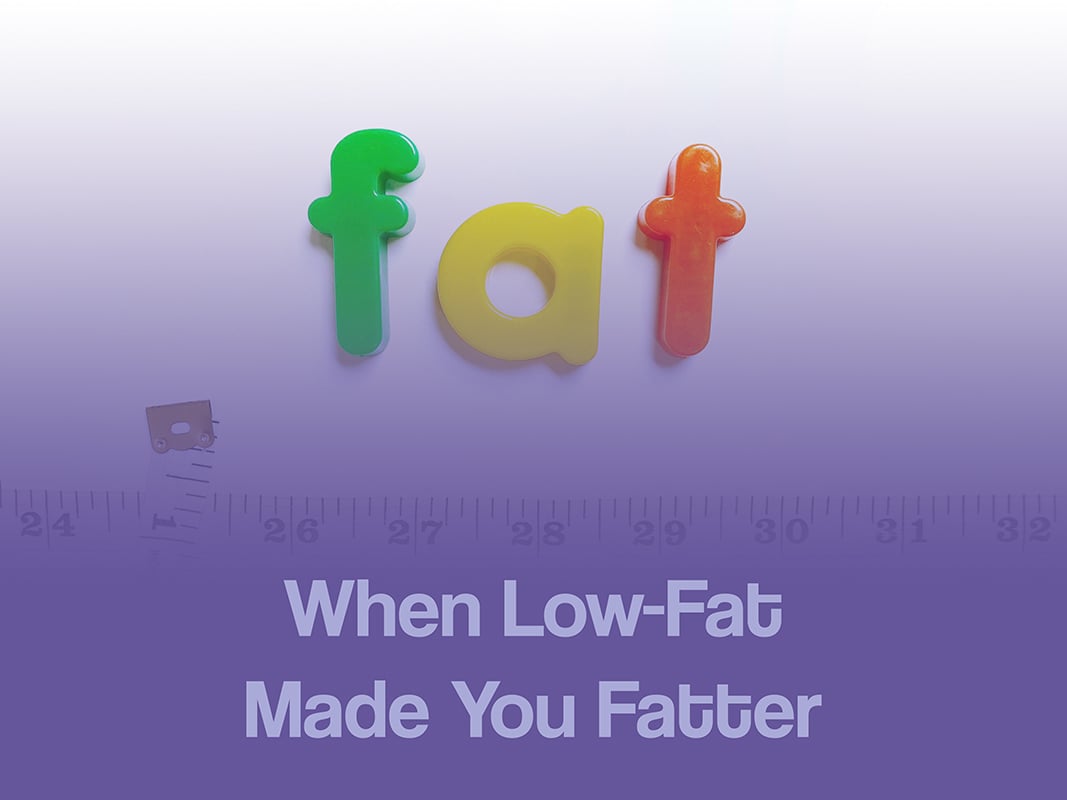By Yeo Chee Yew

In Part 1 of this article series, we revisit the dark birth of the "low-fat" label.
Low-Fat: What Happened Next?
Trans Fat
As the western world (and similarly Singapore) got swept up by the promises touted by a low-fat diet, the food industry got to work replacing the animal fats in their products with unsaturated vegetable oils. Some of the changes they had to make included altering the structure of the vegetable oil so it could be used in the place of solid fats. Enter hydrogenation, which created a solid or semi-solid fat thought to be more appropriate for their food processing needs.
Unfortunately, we now know these hydrogenated fats increase levels of dangerous trans fats which are both bad for the heart and our cholesterol. Although trans fats can be found at low levels in some natural foods, these man-made counterparts meant it was likely we were eating more of them.
Back to Sugar
But low-fat foods at least cut out something, right? Wrong! When you take the fat out of food, it makes food taste worse. So to make it more palatable, food companies typically add a little something. Hello again to our not so dear friend, sugar, and piles and piles of it.
All of this meant that the typical low-fat product tended to be high in carbs, might contain trans-fats and at the end of the day had a very similar calorie count to the original product. A diet too high in these refined carbs and sugars can be as unhealthy as a high-fat diet because it increases the risk of diabetes and heart disease, as well as causes high cholesterol levels.
As the consumption of saturated fat decreased by about 40 percent, the consumption of refined grains, i.e. carbohydrates that convert to sugar in the body, increased substantially. The total intake of calories also began to increase. These happen in no small part because food companies took advantage of the low-fat craze.
What you end up with is your local FairPrice (or any other supermarket) being stocked full of supposedly healthy low-fat but high sugar foods, a phenomenon that still holds true today. Unfortunately, food that is high in sugar stimulates reward centres in the brain, leaving us wanting more. All these culminate in a fatter population with greater health issues like Type 2 diabetes.
Taking Back Control
How do we get ourselves out of this spiral? There are many options available. For some, it is a low carb, high-fat diet. For others, it is a Mediterranean diet. It could be a vegetarian diet or something else entirely. You need to find the best solution for YOU.
And that’s the point: we need to take responsibility for our own health. It could be picking up a new sport, enrolling for a class on Circle, or consulting an ActiveHealth expert. Find what works uniquely for you, and stick to it!
To receive the latest updates on the happenings in the Singapore sports scene, follow GetActive TV on Facebook and Instagram!
Related Articles
Related Topics
Recent Events & Programmes
Related Articles
Related Topics
Related Articles
View All
Related Topics
[BlogPost 164238055490 Evergreen Aleksandar Duric Still Making Headlines at 53, BlogPost 164170080646 NSG 2024 Rope Skipping: Junior Div Girls Freestyle Team Finals, BlogPost 162884973666 Move and Rest Better With Data From Your Own Body, BlogPost 163393049482 Life Comes Full Circle For Serangoon Garden Secondary School's Fahrish Khan, BlogPost 163258797651 Making Golf a Sport for All, BlogPost 162512222328 NSG 2024 Sepaktakraw: Senior Div Yuhua Primary School vs Qihua Primary School, BlogPost 162233592997 Gritty Lions Suffer Loss to China, BlogPost 162089384371 On Your Mark, Get Ready, Go Running, BlogPost 161670652697 Lions' Excellent Showing Against China, BlogPost 161435270031 Ogura Optimistic for Exciting Clash against China, BlogPost 161127614758 The Future of Basketball in Singapore: Why 3x3 is Here to Stay, BlogPost 161033673012 The Active Lifestyler's Guide to the New ActiveSG Delta Sport Centre, BlogPost 161128356680 Grand New Champions Crowned at WTT Singapore Smash 2024, BlogPost 160844835218 NSG 2024 Table Tennis: C Div Boys Pool Round, BlogPost 160210745115 NSG 2024 Basketball: Senior Div Girls Tampines Primary School vs Frontier Primary School, BlogPost 159881180544 Whirlwind Return to Women's Football, BlogPost 159633541417 Singapore Smash to Elevate a New Legacy, BlogPost 158983580420 NSG 2024 Rugby: B Div Damai Secondary School vs Peirce Secondary School, BlogPost 159003960202 SFA Fiesta: Kicking off 2024 to a Roaring Start, BlogPost 158830735126 NSG 2024 Football: B Div Girls Preliminary Round Meridian Secondary School VS Bowen Secondary School, BlogPost 158536989718 Team Nila Volunteers Recognized At Awards Ceremony, BlogPost 158270107806 NSG 2024 Hockey: B Div Boys Preliminary Round Raffles Institution VS St. Hilda Secondary School, BlogPost 157966862615 NSG 2024 Floorball: B Division Preliminary Rounds Kick Off!, BlogPost 157562433712 What Is Safe Sport?, BlogPost 157559446197 Sengkang Secondary: Cultivating Well-Rounded Footballers, BlogPost 157368261167 New National Training Centre for Cricket at West Coast Ground, BlogPost 155340164987 Active Ageing with Joey Bonifacio, BlogPost 155930815517 Inaugural Singapore Youth League kicks off from 24th February 2024, BlogPost 155340164727 Bukit Canberra : the Coolest Spot in the North, BlogPost 155368905255 How Padang Fandi Inspired Ayden to Chase his Dream, BlogPost 154755572826 Ageing Backwards with Elizabeth Cheang, BlogPost 154094657315 Running For Fitness, BlogPost 153318636178 Excitement Builds for FIBA 3x3 Asia Cup 2024, BlogPost 153198644247 World's Top Four Confirmed for 2024 HSBC Women's World Championship, BlogPost 149413941770 Cultivating Your Kids’ Interest in the Outdoors, BlogPost 149413941163 Making Sport More Appealing for Our Kids, BlogPost 149412549409 Solo Or Team Sport – Choosing the Best for Your Child, BlogPost 151197478798 Former Lions Stalwart Baihakki Khaizan Sheds Light on New Accreditation to Elevate Grassroots Football and Youth Development, BlogPost 80703591291 New Year, Fitter You! Here are the top 3 workouts for the New Year, BlogPost 81171151456 7 Reasons Why Sports are Great for Children’s Mental Health, BlogPost 80542065330 17 Best Yoga Classes & Studios in Singapore [+ Rating & Prices], BlogPost 149404351798 From Brush to Lens: A Student's Journey in the World of Art and Sports Photography, BlogPost 149402825063 The Benefits of Active Parenting, BlogPost 149397832009 Sweden Claim 9th Straight Gold at the Women's World Floorball Championship, BlogPost 149397831449 Lion City Sailors Win 2023 Singapore Cup, BlogPost 148511324266 Pitch Perfect with Jonathan Teo, BlogPost 148511724402 Seniors: Increase your flexibility bit by bit with these stretches, BlogPost 147866574167 A Valuable Experience In Spain for Singapore's National Development Centre U-14 Boys, BlogPost 146915317264 How one magical Kallang night changed the lives of Abirami and Daania forever, BlogPost 80700409988 Strength Training for Seniors]









